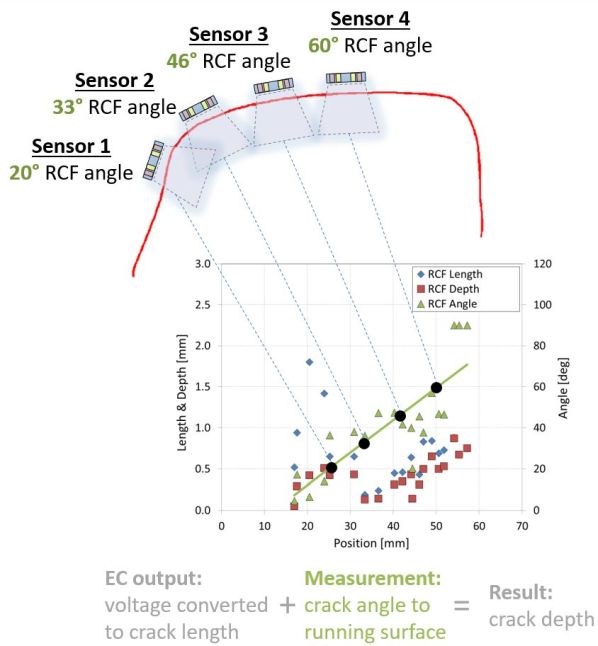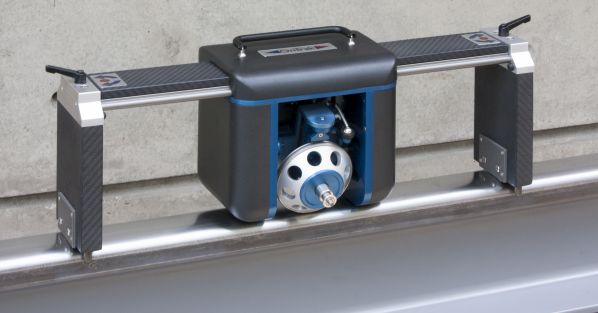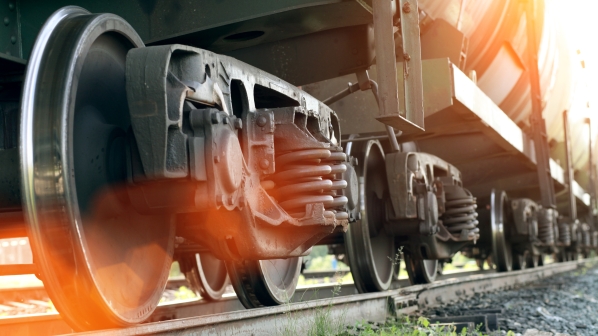ROLLING contact fatigue (RCF) and its effect on wheel and rail life represents a significant issue for rail freight, passenger and urban transit systems. However, with factors such as rail and wheel profiles, vehicle-track dynamics, material properties, and friction conditions driving its development, it’s difficult to identify the root cause or causes of RCF in the field.
Work like this is better done, in part, through modelling that combines multibody dynamics simulations of the vehicle-track interaction with contact mechanics and damage models that simulate wheel-rail contact phenomena. The International Collaborative Research Initiative (ICRI) on RCF and wear of rails and wheels has been doing just this - working to refine vehicle-track interaction and damage models and maintenance processes, and to perform safety and economic evaluations associated with RCF and wear.
The ICRI, formed in 2013, has initiated and coordinated several projects relating to RCF, wear and vehicle-track performance. Among its projects is one to quantify rail surface damage by establishing relationships between visible damage, such as that seen in machine vision images, and the actual measured depth of damage.
Eddy current crack-length measurements, machine vision images, magnetic particle enhanced photographs and MiniProf rail profiles, along with metallurgical sectioning of more than 20 rail samples from three Class 1 railways, have supported this effort. Figure 1 illustrates one outcome of the project: that the angles at which cracks propagate depend on their position across the rail head. This is directly applicable to eddy current systems that measure crack length, since in order to provide a measure of depth they must know the angle of the crack to the surface.

The rail condition data is also in use in an ICRI project on damage modelling aimed at developing credible models of damage initiation and propagation that can be applied to specific curves under realistic loading conditions.
The quantify surface damage and damage modelling projects are an outcome of the predictive rail grinding initiative that was developed and hosted by Mr Dan Hampton, manager of contract services at CSX. Hampton is looking for methods to optimise CSX’s rail grinding budget and provide a better understanding of the current and predicted state of rail damage in order to assign grinding resources more efficiently. He proposed an ICRI-led project with several collaborating parties - Loram, MRX, Rohmann, Sperry, National Research Council of Canada - to collect, share, and analyse data that measures and quantifies rail surface conditions over long stretches of track. (Aspects of the project were also supported by Norfolk Southern, Canadian National and BNSF.)
Each technology addresses a different aspect of the surface damage.
Hampton says that the study is pursuing a common, industry-accepted Rail Surface Damage Index (RSDI) that identifies visual surface conditions, subsurface damage, and the associated depth of cut needed to remove the majority of cracks. Due to the variability of measurement results between different products, which use various technologies with differing numbers of sensors and sensor locations along the rail head to measure damage, there is a need to correlate individual results to a common damage index that is directly related to the current stage of crack growth and the depth of cut required to remove surface cracks.
Each technology addresses a different aspect of the surface damage. By combining data outputs from multiple systems and aligning the cumulative results to the common RSDI, it is possible to assess and undertake corrective actions regardless of the technology used. When analysed run-after-run, the rate of deterioration can be used to predict damage when accounting for rail quality and the degree of curvature.
The use of a common scoring approach from multiple sources also allows data to flow more effectively into a predictive model. The study identified variations between conditions at the subsurface versus the surface of the rail, and showed that additional research on crack growth behaviour relative to metallurgy is needed. This would include investigation into how the micro grain structure and cleanliness of the rail in combination with the location on the rail head - gauge corner, corner-centre, centre, field - affect the crack angle and speed of crack growth relative to tonnage.
Wear mapping
Rail and wheel wear have a significant economic impact on railways, not only in terms of wheel and rail replacement costs, but also maintenance. Vehicle-track models therefore frequently predict wear.
Wear maps correlate the rate of wear with contact stress and sliding velocity. The maps most often used are based on surprisingly sparse data for a limited number of materials under a narrow range of conditions. Hundreds and thousands of wear tests have been performed and reported by individuals and organisations, but because of differences in methodologies and inadequate detailing, they are difficult or impossible for others to use.
The ICRI took on a Wear Mapping project to improve on this. The project, led by Dr Roger Lewis at Sheffield University, will:
- identify and publish a best practice for performing and reporting wear testing - a review of wear testing methodologies for wheel and rail materials found that while only a few different techniques are used, there is wide variety in exactly how the tests are conducted and results reported
- review existing wear maps and identify gaps for future testing
- collect and compile existing wear data from published and non-published sources - a detailed spreadsheet has been developed and is available through the ICRI, and
- develop “universal” wear maps that take account of the full range of operating environmental conditions prevalent for the wheel/rail contact. These have been developed and are applied in several recently presented papers.
Friction modelling
Friction at the wheel-rail interface dictates the tangential forces that govern rail-vehicle dynamic response and drive the damage phenomena - plastic flow, rolling contact fatigue, and wear - that typically determine wheel and rail life cycle costs.
In practice, wheel-rail friction characteristics can vary widely. While significant effort may go into developing and parameterising a vehicle-track dynamic model, the specifics of the wheel-rail interface are seemingly an afterthought. The effect of the third body - the material between wheel and rail - in wheel-rail contact is often represented by nothing more complicated than a coefficient of friction. But the third body layer, a mix of desired elements - sand, lubricants, greases, friction modifiers - and undesired elements - metal oxides, organic debris, moisture - plays a significant role in friction management.
While friction-related static and dynamic values are generally understood, there is also a “friction characteristic” that dictates the shearing (traction and braking) forces that develop at the wheel-rail contact - a characteristic that is dependent upon the relative motion, or slip, between the wheel and rail. Depending on the relative velocities within the contact patch, stick and slip zones develop. The “default” relationship, which applies to very clean steel on steel surfaces, has the effective friction value asymptotically reaching a maximum (also called creep saturation) at a slip rate corresponding to sliding over the full contact patch.
Reality is more complex. The contacting surfaces are rough and thus contact may not be continuous. The third body has its own material properties, which may vary as a function of the temperature developed in the contact patch. The saturation creepage may be significantly increased or the effective friction value may reach a maximum and then begin to fall as the slip rate continues to increase. Falling friction introduces negative damping, often seen as responsible for some forms of wheel/rail noise, as well as wheel polygonisation and rail corrugation. Those modelling vehicle behaviour are faced with the question: when is it important to accurately represent the traction creepage characteristic versus simply using the limiting friction value and “default” relationships?
Multiple organisations are working on improved wheel-rail friction models and the ICRI has supported these efforts through web conferences and workshops. Several ICRI participants have earned research funding from the US Federal Railroad Administration (FRA).
VORtech CMCC in the Netherlands is developing physics-based sub-models for temperature, surface roughness, third-body characteristics, and local plasticity in the contact patch, which will be added to the Extended Contact model for rolling contact. In addition, the University of Sheffield, Virtual Vehicle Research Centre in Austria, and LB Foster in Canada are developing a model to predict consumption, carry down, and related friction of top-of-rail products, including friction modifiers - water-based and oil - and grease-based lubricants, that are applied by wayside applicators. This effort combines small - and full-scale testing with theoretical modelling.
In parallel, work is underway to better measure wheel-rail friction in field conditions. OnTrak is developing a portable tribometer to measure the friction versus slip characteristic between a measuring wheel and any location across the rail running surface. This development is supported by Transportation Technology Center, Inc (TTCI). The FRA has also contributed funding to evaluate tribometer prototype designs.

VTI-Economics
One of the lessons from the first annual ICRI workshop held in Vancouver in 2016 was that technological breakthroughs often fail to get the traction they deserve because economic or other benefits are not effectively translated or communicated to higher level stakeholders and decision makers.
To support the industry, ICRI assembled a team to help the industry better understand the costs of track and vehicle maintenance and to make the economic case for technology investment. The small group of volunteers from North America and Europe worked to create an open and accessible economic model for evaluating the economic impact of research, technology investments, and process improvements.
The VTI-Economics model is a spreadsheet-based tool developed in partnership with more than a dozen railways and suppliers that leverages data from different departments and specialists. To date, it has been applied by three freight railways and 11 transit systems in the US, Britain, and Australia.
For example, the VTI-Economics model was used in 2018 by Bay Area Rapid Transit (Bart) to project the savings associated with implementing a new wheel profile across the fleet. By comparing the wheel mean time between retruing, refurbishment and replacement costs before and after the new profiles were introduced, Bart was able to project a $US 1.9m annual saving from the significant reductions in wheel wear offered by the improved wheel-rail interface.
“The custom VTI economics model developed for Bart’s unique wheel maintenance cycle was extremely valuable in projecting the financial performance of our wheel profile modernisation project,” says Mr Charles Franz, Bart’s vehicle systems engineer. “It is actively helping us forecast demand, budget efficiently, and shows tangible progress on our journey toward a state of good repair.”
The ICRI VTI-Economics Group now plans to apply the model to projects on turnout maintenance and safety on railways in the EU, Australia, and South America.
The International Collaborative Research Initiative (ICRI)
ICRI brings together people already working on common topics with the goal of building a stronger professional network, develop joint publications, and, in some cases, to form teams to obtain research funding from outside the ICRI.
ICRI currently includes about 200 members from research organisations, universities, railways, suppliers, government agencies and consultants. All contributions are “in-kind” with participants contributing time, data and experience from existing projects or out of personal or professional interest. The exception is the financial sponsorship that ICRI receives from the US Federal Railroad Administration and Transport Canada to support administration.
While nominally focused on wear and RCF in rails and wheels, ICRI is willing to champion other projects in need of research. The 4th Annual ICRI workshop will be held in in Vancouver, Canada, on July 23-25. Participation from the rail industry, especially persons with economics and safety analysis capabilities, is welcome.
*Authors and ICRI members:Eric Magel, principal engineer, National Research Council, Canada; Wesley Thomas, vice-president - rail, Sentient Sciences; Peter Klauser, president, Vehicle Dynamics.

